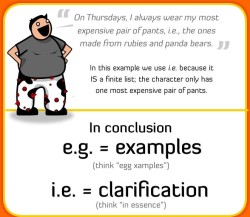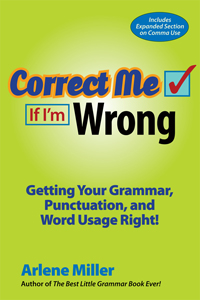 Most people know what etc. means, but sometimes i.e. and e.g. can be confusing. They are all Latin phrases, and here are the translations:
Most people know what etc. means, but sometimes i.e. and e.g. can be confusing. They are all Latin phrases, and here are the translations:
etc. – et cetera – means and others
e.g. – exempli gratia – means for example
i.e. – id est – means that is
1. etc. – Used at the end of a list in text:
The wedding had an Italian menu, which consisted of pasta, pizza, lasagna, cannelloni, etc.
Etc. is often best avoided, especially in text. It is fine in a table or chart. Alternatives are to just say and others or and more, or just to list everything. Sometimes you can even use for example instead:
The wedding had an Italian menu, for example, pasta, pizza, lasagna, and cannelloni.
2. e.g. – used instead of for example
Once again e.g. is best avoided, particularly in formal writing, although it is fine in charts and tables. Why not just say for example? If you want to use e.g., make sure you put periods after both letters, and commas before and after the expression. Do not put e.g. in italics or bold or quotes. (I am doing so because I am using it as itself here, and I also want it to stand out.) If you are putting a complete sentence after e.g. or for example, you can put a semicolon between the sentences. You can also put e.g. in parentheses. All the following examples are correct.
The wedding had an Italian theme, e.g., the menu was completely Italian. (You could also use a semicolon before e.g. or for example. When a complete sentence follows e.g., using either a comma or semicolon before it is acceptable.)
The wedding had an Italian theme, for example, all Italian food.
The wedding had an Italian theme; for example, all the food was Italian.
The wedding had an Italian theme (e.g., the menu was completely Italian).
3. i.e. – used instead of that is
The exact same punctuation rules apply to i.e. and e.g. Use a period after each letter and a comma before and after the expression. If a complete sentence follows the expression, you can use a semicolon rather than a comma before it. Of course, you could use a period instead of the semicolon, but you aren’t afraid of semicolons, right? You can also spell it out instead of using i.e., and you can put it in parentheses. However, i.e. doesn’t mean the same thing as e.g., and they are not interchangeable — usually. (Sometimes they are pretty close.)
I am taking two languages this year, i.e., Spanish and Italian.
In the above sentence, e.g. would be incorrect. You are not using Spanish and Italian as examples. Instead, you are explaining that you are taking two languages by telling what they are. Notice that i.e. is really an equal sign (the two languages equal Spanish and Italian).
I am proud that my son is the drum major for the band; i.e., he is leading the marching band.
In the above sentence you are explaining what you mean by drum major. Once again, you see that i.e. is an equal sign, saying that drum major equals the person who leads the marching band.
Simple?



Available on Amazon



Thanks for letting us know it’s also correct to use a semicolon before e.g. and I.e.
You can use the semicolon before i.e. and e.g. only when a complete sentence follows them, though.